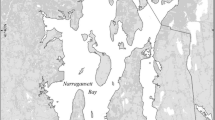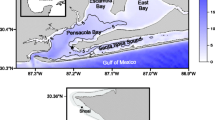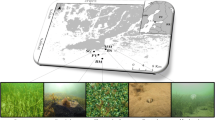Abstract
Net system production ranged from 13% to 29% of apparent system production in enclosures modelling coastal marine waters. Net production was measured by direct and indirect methods along with factors which impact its magnitude and fate. The direct measures of carbon, phosphorus, and nitrogen content of accumulating flocculent material in enclosures without sediment agreed with indirect measures by net system metabolism and by net sediment storage from nutrient mass balances. Increased nutrient supply, increased the absolute, but not relative, net system production ultimately stored in the sediment. Net production as dry weight of floc did not agree with that calculated from oxygen metabolism owing to a high silicon content of the organic matter. The presence of a benthic macrofauna decreased net system production storage by about 28–54%.
Similar content being viewed by others
Literature Cited
Bunt, J. S. 1975. Primary productivity of marine ecosystems, chapter 8, p. 169–183.In A. Lieth and R. H. Whittaker (eds.), Primary Productivity of the Biosphere. Springer-Verlag, New York.
Doering, P. H. 1989. On the contribution of the benthods to pelagic production.Journal of Marine Research 47:371–383.
Doering, P. H., C. A. Oviatt, L. L. Beatty, V. F. Banzon, R. Rice, S. P. Kelly, B. K. Sullivan, andJ. B. Frithsen. 1989. Structure and function in a model coastal ecosystem: Silicon, the benthos and eutrophication.Marine Ecology Progress Series 52:287–299.
Froëlich, P. N., M. L. Bender, N. A. Leadtke, G. R. Heath, andT. DeVries. 1982. The marine phosphorus cycle.American Journal of Science 282:474–511.
Grassle, J. F., J. P. Grassle, L. S. Brown-Ledger, R. F. Petracca, andN. J. Copley. 1985. Subtidal macrobenthos of Narragansett Bay. Field and mesocosm studies of the effects of eutrophication and organic input on benthic populations, p. 421–434.In J. S. Gray and M. E. Christiansen (eds.), Marine Biology of Polar Regions and Effects of Stress on Marine Organisms. Wiley, New York.
Jahnke, R. A., C. E. Reimers, andD. B. Craven. 1990. Intensification of recycling of organic matter at the sea floor near ocean margins.Nature 348:50–54.
Koblentz-Mishke, O. J., U. V. Volkovinsky, andJ. G. Kavonova. 1970. Plankton primary production of the world ocean, p. 183–193.In W. S. Wooster (ed.), Exploration of the South Pacific. National Academy of Science, Washington, D.C.
Mann, K. H. andJ. R. N. Lazier. 1991. Dynamics of Marine Ecosystems Biological-Physical Interactions in the Oceans. Blackwell Scientific Publication, Cambridge, Massachusetts. 466 p.
Martin, J. H., G. A. Knauer, D. M. Karl, andW. W. Broenkow. 1987. VERTEX: Carbon cycling in the northeast Pacific.Deep Sea Research 34:267–285.
Nixon, S. W. 1987. Chesapeake Bay nutrient budgets—A reassessment.Biogeochemistry 4:77–90.
Nowicki, B. L. andC. A. Oviatt. 1990. Are estuaries traps for anthropogenic nutrients? Evidences from estuarine mesocosms.Marine Ecology Progress Series 66:131–146.
Odum, E. P. 1971. Fundamentals of Ecology. 3rd edition. W.B. Saunders Co., Philadelphia. 574 p.
Odum, H. T. andC. M. Hoskin. 1958. Comparative studies of the metabolism of marine waters.Publications of the Institute of Marine Science, University of Texas 5:16–46.
Oviatt, C. A., A. Keller, P. Sampou, andL. L. Beatty. 1986. Patterns of productivity during eutrophication: A mesocosm experiment.Marine Ecology Progress Series 28:69–80.
Oviatt, C. A., J. G. Quinn, J. T. Maughan, J. T. Ellis, B. K. Sullivan, J. N. Gearing, P. J. Gearing, C. D. Hunt, P. A. Sampou, andJ. S. Latimer. 1987. Fate and effects of sewage sludge in the coastal marine environment: A mesocosm experiment.Marine Ecology Progress Series 41:187–203.
Parsons, T. R., M. Takahashi, andB. Hargrave. 1988. Biological Oceanographic Processes. 3rd edition. Pergamon Press, New York. 330 p.
Rudnick, D. T. andC. A. Oviatt. 1986. Seasonal lags between organic carbon deposition and mineralization in marine sediments.Journal of Marine Research 44:815–837.
Walsh, J. J. 1991. Importance of continental margins in the marine biogeochemical cycling of carbon and nitrogen.Nature 350:53–55.
Watson, A. J., C. Robinson, J. E. Robinson, P. J. le B. Williams, andM. J. R. Fasham. 1991. Spatial variability in the sink for atmospheric carbon dioxide in the North Atlantic.Nature 350:50–53.
Winer, B. J. 1971. Statistical Principals in Experimental Design. 2nd edition. McGraw Hill, New York. 907 p.
Author information
Authors and Affiliations
Rights and permissions
About this article
Cite this article
Oviatt, C.A., Doering, P.H., Nowicki, B.L. et al. Net system production in coastal waters as a function of eutrophication, seasonality and benthic macrofaunal abundance. Estuaries 16, 247–254 (1993). https://doi.org/10.2307/1352497
Received:
Accepted:
Issue Date:
DOI: https://doi.org/10.2307/1352497




